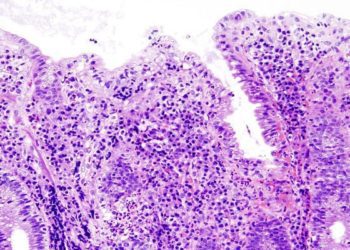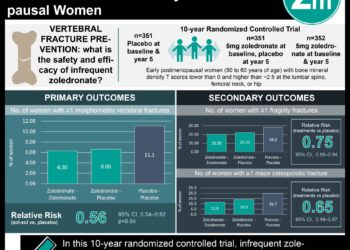Growth factor embedded film promotes robust bone repair
1. Scaffolds coated with a polyelectrolyte multilayer (PEM) film released growth factors (GFs) with individual temporal control during bone reconstruction.
2. PEM films containing platelet-derived growth factor-BB (PDGF-BB) and bone morphogenetic protein-2 (BMP-2) promoted robust new bone formation that recapitulated native bone in the rat.
Evidence Rating Level: 2 (Good)
Study Rundown: The current gold standard for repairing a bony defect involves autograft (self-to-self) bone transplant. This entails collecting bone from the donor site of a patient and transplanting that bone to their defect location. This practice is hindered by a limited amount of donor bone, patient discomfort, and potential infection at the donor site. A number of studies have investigated artificial scaffolds as an alternative to autologous bone transplant, but success has been limited by the low frequency of scaffold integration with the existing bone for formation of a stable structure. Loading of these scaffolds with growth factors (GFs) that are known to promote bone repair have also experienced limited success, largely because the GFs diffuse quickly out of the scaffold, resulting in a bolus, rather than a sustained delivery.
Researchers have now created a thin PEM film that can be applied to scaffolds which releases growth factors in a slow, controlled fashion. Both PDGF-BB and BMP-2 are known to drive bone repair, though in different ways and in different phases of the repair process. Using layer-by-layer deposition, researchers were able to control the film patterning, and consequently, the release of these two factors. They found that, in a rat bone wound model, early release of PDGF-BB followed by a longer, more sustained release of BMP-2 improved bone repair and reconstruction. The new bone formed in the presence of the controlled release of BMP-2 and PDGF-BB was similar to native bone in both mechanical and histological comparisons. In control experiments with uncoated scaffolds and BMP-2-only scaffolds, bone repair was less robust. While this experiment was done in mice, future large animal studies and clinical trials will investigate the promising role of controlled release of growth factors for driving quality bone reconstruction. The promise of inducing bone repair without implantation of cells or full autografts should greatly increase the accessibility and success of defect repair surgery.
Click to read the study in Proceedings of the National Academy of Sciences
Relevant Reading: Growth Factors Engineered for Super-Affinity to the Extracellular Matrix Enhance Tissue Healing
In-Depth [animal study]: This study used PEM-film-coated scaffolds to investigate the controlled release of growth factors, BMP-2 and PDGF-BB, in promoting bone defect repair. Controlled deposition of Poly2, poly(acrylic acid), and PDGF-BB or BMP-2, created a multilayer film that was used to coat a degradable poly(lactic-co-glycolic acid) scaffold. Scaffolds, uncoated or coated with PEMs containing solely BMP-2 or BMP-2 and PDGF-BB, were implanted into a skull-base defect in a skeletally mature rat. Bone repair was monitored by microcomputed tomography at 1, 2 and 4 weeks after implantation. Very little bone repair occurred in rats having received uncoated scaffolds, whereas defects were completely filled by week 4 in rats having received the PEM-coated scaffolds. Interestingly, when evaluated for bone-like characteristics, the new bone formation promoted by BMP-2 alone lacked the compactness and mineralization characteristic of native bone. Alternatively, the controlled release of BMP-2 and PDGF-BB resulted in full defect repair with bone that recapitulated native bone by both histological and mechanical analysis, including stiffness and compression tests.
More from this author: The 3C Study: Alemtuzumab may reduce acute rejection following kidney transplant, Paclitaxel-coated balloons may decrease bronchial stenosis in lung transplants,Chemokines in cardiac allografts promote graft rejection in mice, Modulating lymphocyte populations decreases graft rejection in mice,Adding Evolocumab to statin therapy further decreases LDL-C levels
©2012-2014 2minutemedicine.com. All rights reserved. No works may be reproduced without expressed written consent from 2minutemedicine.com. Disclaimer: We present factual information directly from peer reviewed medical journals. No post should be construed as medical advice and is not intended as such by the authors, editors, staff or by 2minutemedicine.com. PLEASE SEE A HEALTHCARE PROVIDER IN YOUR AREA IF YOU SEEK MEDICAL ADVICE OF ANY SORT.






